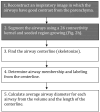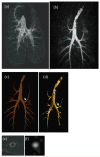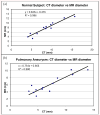Measurement of lung airways in three dimensions using hyperpolarized helium-3 MRI
- PMID: 21521907
- PMCID: PMC3159390
- DOI: 10.1088/0031-9155/56/10/014
Measurement of lung airways in three dimensions using hyperpolarized helium-3 MRI
Abstract
Large airway measurement is clinically important in cases of airway disease and trauma. The gold standard is computed tomography (CT), which allows for airway measurement. However, the ionizing radiation dose associated with CT is a major limitation in longitudinal studies and trauma. To avoid ionizing radiation from CT, we present a method for measuring the large airway diameter in humans using hyperpolarized helium-3 (HPHe) MRI in conjunction with a dynamic 3D radial acquisition. An algorithm is introduced which utilizes the significant airway contrast for semi-automated segmentation and skeletonization which is used to derive the airway lumen diameter. The HPHe MRI method was validated with quantitative CT in an excised and desiccated porcine lung (linear regression R(2) = 0.974 and slope = 0.966 over 32 airway segments). The airway lumen diameters were then compared in 24 human subjects (22 asthmatics and 2 normals; linear regression R(2) value of 0.799 and slope = 0.768 over 309 airway segments). The feasibility for airway path analysis to areas of ventilation defect is also demonstrated.
Figures









Similar articles
-
Comparison of airway diameter measurements from an anthropomorphic airway tree phantom using hyperpolarized 3He MRI and high-resolution computed tomography.Magn Reson Med. 2007 Sep;58(3):636-42. doi: 10.1002/mrm.21285. Magn Reson Med. 2007. PMID: 17763351 Free PMC article.
-
Spatial Comparison of CT-Based Surrogates of Lung Ventilation With Hyperpolarized Helium-3 and Xenon-129 Gas MRI in Patients Undergoing Radiation Therapy.Int J Radiat Oncol Biol Phys. 2018 Nov 15;102(4):1276-1286. doi: 10.1016/j.ijrobp.2018.04.077. Epub 2018 May 10. Int J Radiat Oncol Biol Phys. 2018. PMID: 30355463
-
Hyperpolarized 3He magnetic resonance imaging ventilation defects in asthma: relationship to airway mechanics.Physiol Rep. 2016 Apr;4(7):e12761. doi: 10.14814/phy2.12761. Physiol Rep. 2016. PMID: 27053294 Free PMC article.
-
Demonstration of the heterogeneous distribution of asthma in the lungs using CT and hyperpolarized helium-3 MRI.J Magn Reson Imaging. 2010 Dec;32(6):1379-87. doi: 10.1002/jmri.22388. J Magn Reson Imaging. 2010. PMID: 21105142 Review.
-
Functional MRI of the lung using hyperpolarized 3-helium gas.J Magn Reson Imaging. 2004 Oct;20(4):540-54. doi: 10.1002/jmri.20154. J Magn Reson Imaging. 2004. PMID: 15390146 Review.
Cited by
-
Modeling Realistic Geometries in Human Intrathoracic Airways.Diagnostics (Basel). 2024 Sep 7;14(17):1979. doi: 10.3390/diagnostics14171979. Diagnostics (Basel). 2024. PMID: 39272764 Free PMC article. Review.
-
In Vivo Computed Tomography as a Research Tool to Investigate Asthma and COPD: Where Do We Stand?J Allergy (Cairo). 2012;2012:972479. doi: 10.1155/2012/972479. Epub 2012 Jan 11. J Allergy (Cairo). 2012. PMID: 22287977 Free PMC article.
-
Tentative study on radial endobronchial ultrasonography evaluating airway wall thickness before and after bronchial thermoplasty.Respir Med Case Rep. 2022 Jan 5;36:101571. doi: 10.1016/j.rmcr.2021.101571. eCollection 2022. Respir Med Case Rep. 2022. PMID: 35036303 Free PMC article.
-
Evaluation of sex-based differences in airway size and the physiological implications.Eur J Appl Physiol. 2021 Nov;121(11):2957-2966. doi: 10.1007/s00421-021-04778-2. Epub 2021 Jul 31. Eur J Appl Physiol. 2021. PMID: 34331574 Review.
-
Redistribution of inhaled hyperpolarized 3He gas during breath-hold differs by asthma severity.J Appl Physiol (1985). 2016 Mar 1;120(5):526-36. doi: 10.1152/japplphysiol.00197.2015. Epub 2015 Dec 3. J Appl Physiol (1985). 2016. PMID: 26635346 Free PMC article.
References
-
- Albert MS, Cates GD, Driehuys B, Happer W, Saam B, Springer CS, Jr, Wishnia A. Nature. Vol. 370. 1994. Biological magnetic resonance imaging using laser-polarized 129Xe; pp. 199–201. - PubMed
-
- Aysola RS, Hoffman EA, Gierada D, Wenzel S, Cook-Granroth J, Tarsi J, Zheng J, Schechtman KB, Ramkumar TP, Cochran R, Xueping E, Christie C, Newell J, Fain S, Altes TA, Castro M. Airway remodeling measured by multidetector CT is increased in severe asthma and correlates with pathology. Chest. 2008;134:1183–91. - PMC - PubMed
-
- Barger AV, Block WF, Toropov Y, Grist TM, Mistretta CA. Time-resolved contrast-enhanced imaging with isotropic resolution and broad coverage using an undersampled 3D projection trajectory. Magn Reson Med. 2002;48:297–305. - PubMed
-
- Brown RH, Mitzner W. Effect of lung inflation and airway muscle tone on airway diameter in vivo. J Appl Physiol. 1996;80:1581–8. - PubMed
-
- Brown RH, Mitzner W, Wagner E, Permutt S, Togias A. Airway distension with lung inflation measured by HRCT. Acad Radiol. 2003;10:1097–103. - PubMed
Publication types
MeSH terms
Substances
Grants and funding
LinkOut - more resources
Full Text Sources
Medical
